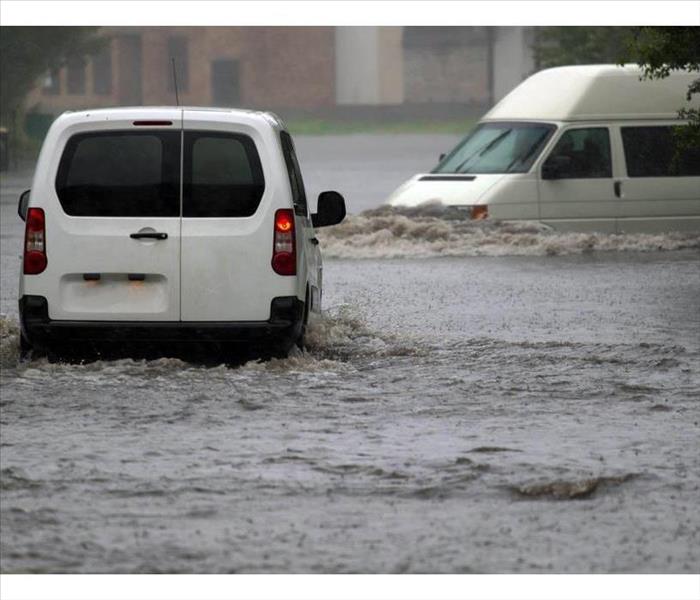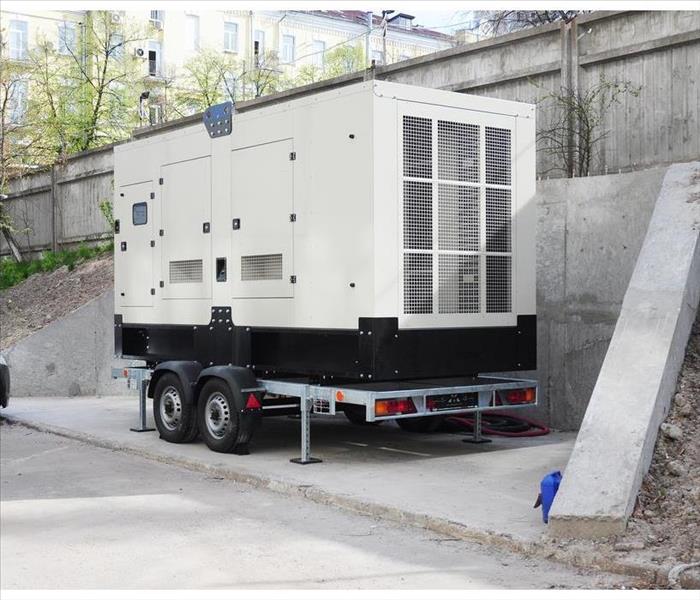Recent Storm Damage Posts
After the Storm: Assessing Structural Damage with Precision
1/4/2024 (Permalink)
Severe storms can leave a trail of destruction in their wake, and assessing structural damage is a critical step in the aftermath. Whether it's wind, hail, or heavy rainfall, understanding the condition of your property is essential for prompt and effective repairs. In this blog, we'll guide you through a comprehensive process of assessing structural damage after a severe storm, ensuring that no hidden issues compromise the integrity of your home.
Safety First
Before conducting any assessment, prioritize safety. Ensure that the storm has completely passed and that it's safe to approach and inspect the property. Beware of downed power lines, unstable structures, and other hazards.
Exterior Inspection
Begin with a thorough exterior inspection. Look for visible signs of damage, including:
- Missing or damaged roof shingles.
- Dents or cracks in siding.
- Broken windows or damaged window frames.
- Leaning or damaged chimneys.
Roof Assessment
The roof is often the most vulnerable part of a structure during a storm. Carefully inspect the roof for:
- Missing or lifted shingles.
- Dents, cracks, or punctures in metal roofing.
- Water stains on the ceiling, indicating potential leaks.
- Use binoculars to assess high or steep roofs safely, and consider hiring a professional if you're uncomfortable with heights.
Check Gutters and Downspouts
Inspect gutters and downspouts for blockages caused by debris. Ensure that they are securely attached to the house and not sagging. Proper drainage is essential for preventing water damage.
Window and Door Evaluation
Examine windows and doors for damage, including:
- Broken glass or frames.
- Warped or misaligned doors.
- Cracks in door frames.
- Properly sealed windows and doors are crucial for maintaining the structural integrity of your home.
Foundation Inspection
Assess the foundation for signs of damage, such as:
- Cracks or fractures.
- Uneven settling.
- Water pooling around the foundation.
- Foundation issues can compromise the entire structure, so prompt attention is crucial.
Inspect the Attic
Ascend to the attic to check for:
- Leaks or water stains.
- Damaged insulation.
- Signs of pests or animals that may have entered during the storm.
- Identifying issues early can prevent further damage.
While a homeowner's assessment is crucial, some damage may be subtle or hidden. Consider hiring a professional structural engineer or a qualified home inspector to conduct a thorough evaluation, especially if you have concerns about the stability of your home. Document all visible damage with photographs and notes. This documentation will be essential for insurance claims and working with contractors.
Once you've assessed the damage, contact your insurance provider to report the incident. Provide them with detailed documentation and cooperate fully with their assessment process.
If immediate repairs are necessary to prevent further damage, secure temporary fixes. This may include tarping a damaged roof, boarding up broken windows, or addressing any other critical issues.
Assessing structural damage after a severe storm is a methodical process that requires attention to detail and a commitment to safety. By conducting a comprehensive evaluation, documenting damage, and seeking professional assistance when needed, you can ensure that your home is on the path to recovery. Swift action, coupled with a well-executed repair plan, will not only restore your property but also reinforce its resilience against future storms.
Navigating the Aftermath of Storm and Flood Damage in Southern Texas
9/26/2023 (Permalink)
In the dynamic coastal region of Southern Texas, the beauty of living near the water comes with a unique set of challenges, particularly when it comes to the aftermath of storm surge and flood damage. From hurricane seasons to sudden tropical storms, the potential for water-related damage is a reality for homeowners and property owners. This blog aims to provide valuable insights into the aftermath of storm surges and flood damage, helping you navigate the complexities and take proactive measures to protect your investment.
The Impact of Storm Surge and Flood Damage
Storm surge, driven by powerful winds and low-pressure systems, can lead to significant flooding in coastal areas. When combined with heavy rainfall from storms, the risk of flooding extends well beyond the immediate shoreline. The aftermath of storm surge and flooding can result in:
- Structural Damage: Floodwaters can weaken the foundation of buildings, erode soil, and compromise structural integrity.
- Electrical and Mechanical Systems: Water damage can disrupt electrical systems, appliances, and mechanical equipment, posing safety hazards.
- Health Concerns: Floodwaters can carry contaminants, sewage, and toxins, posing risks to occupants.
- Mold Growth: The combination of moisture and warmth after flooding creates a conducive environment for mold growth, which can lead to significant issues.
Taking Immediate Action
Understanding the importance of swift action after storm surges and flooding is crucial to mitigating further damage. Here are steps to consider:
- Ensure Safety First: Before entering a flooded area, ensure your safety by turning off electricity and gas connections.
- Document the Damage: Take photos and videos of the damage to provide evidence for insurance claims.
- Contact Your Insurance Company: Notify your insurance provider of the damage and start the claims process.
- Water Removal: If safe, begin removing standing water using pumps and wet/dry vacuums.
- Assessment by Professionals: Engage with restoration professionals to assess the extent of the damage, including structural and electrical concerns.
- Drying and Dehumidification: Thoroughly dry the affected areas to prevent mold growth. Dehumidifiers and proper ventilation are essential.
Navigating the Insurance Process
Navigating the insurance process after storm surge and flood damage can be complex. Here are tips to streamline the claims process:
- Review Your Policy: Understand the extent of your coverage and the specific terms related to storm damage and flooding.
- Document Thoroughly: Provide detailed documentation, including photos, videos, and written descriptions of the damage.
- Keep Records: Maintain a record of all communication with your insurance company, including names, dates, and notes of conversations.
- Use Professionals: Utilize professionals for assessments, repair estimates, and documentation to strengthen your claim.
- Be Patient: Insurance claims can take time to process, especially after widespread damage. Stay patient and persistent.
Preventing Future Damage
As Southern Texas is prone to storm surge and flooding, proactive measures can help minimize future damage:
- Elevate Electrical Systems: Elevate electrical outlets and switches to prevent water damage.
- Seal Vulnerabilities: Seal cracks and openings in the foundation and walls to prevent water intrusion.
- Landscape Considerations: Use native plants and proper grading to manage water runoff.
- Elevate Structures: Consider elevating structures in flood-prone areas to reduce potential damage.
- Purchase Flood Insurance: Invest in flood insurance to secure coverage specifically for flooding events.
Navigating the aftermath of storm surge and flood damage in Southern Texas requires vigilance, preparedness, and understanding. By taking immediate action, documenting damage, working with professionals, and staying informed about your insurance policy, you can protect your property and ensure a smoother recovery process. Furthermore, implementing preventive measures can help mitigate future damage, allowing you to enjoy the beauty of coastal living without compromising on safety and security.
What Is a Category Three Water Damage?
8/25/2022 (Permalink)
 Water that is contaminated with feces or raw sewage, such as an overflow from a toilet
Water that is contaminated with feces or raw sewage, such as an overflow from a toilet
Which Water Damage Situations Fit Into This Category
Category 3 water damage is known as black water. This type of water damage can contain bacteria, fungi and unsanitary agents, such as raw sewage. Examples of this type of damage include seawater, storm surge, overflow from streams and rivers, standing water and ground surface water. This type of water damage usually requires the assistance of professionals, so it is important to recognize which water damage situations fit into this category.
Black Water Examples
Several events can lead to water being classified as category 3. You may need to employ the services of a professional water mitigation company in Hilshire Village,TX when you have certain types of damage:
- Water that is contaminated with feces or raw sewage, such as an overflow from a toilet or sewer backup
- Standing water that has been standing long enough to become stagnant
- Floodwater from oceans, streams, rivers, storm surge, or groundwater
What To Do
The steps you should take depend on the cause of your problem. If you have a clogged or overflowing toilet, do not run any of the toilets in your building until the clog has been identified and removed. If you are experiencing a sewage backup, close all of your drain openings with stoppers or plugs to prevent further backup issues and schedule sewage cleanup services.
Close off contaminated areas to prevent contaminants from being spread around your facility on the shoes and clothing of people passing through the area. If you must enter the contaminated area, wear protective gear and remove it before you pass through the rest of your building. Do not move anything from the contaminated area into the rest of your building until you have had a chance to clean and sanitize it.
Dealing with a black water situation is best left a professional restoration service. Properly dealing with the issue can avoid cross-contamination and further damage to your facility.
3 Tips for Business Disaster Preparedness
7/18/2022 (Permalink)
 Preparing your business for disaster includes creating a contingency plan.
Preparing your business for disaster includes creating a contingency plan.
Preparing your company to get back on its feet after a tornado, fire or flood is just as important as paying your rent - but many businesses label this a low priority. Yet without a disaster preparedness plan, your business could face unnecessary losses. Get your Bunker Hill Village, TX business ready - here are three quick ways how.
Top Disaster Risks
Both man and mother nature can be the cause of a disaster. Some of the most potentially devastating incidences include:
- earthquakes
- terror attacks
- flooding
Preparing your business for disaster includes creating a plan with contingencies for all of the above.
Review Your Insurance
One of the easiest ways to prepare for a disaster is making sure you have proper insurance. Review your insurance coverage regularly to make sure you have flood insurance, as well as add-ons for business interruption, loss of use, and extended coverage.
Draft Your Response Plan
A written plan detailing what to do amid a disaster is perhaps one of the most important parts of a disaster preparedness effort. Such business preparedness plans are custom to each business. But at a minimum, they should include things like:
- emergency phone numbers
- A map of the building with emergency exits clearly marked
- Instructions and circumstances for continued operation
Protect Your Data
In a high-tech world, your company’s data can be one of its most invaluable commodities. Make sure your company and its clients are protected during a disaster. Regularly back up files and store in a safe place off-site. That way key proprietary data, as well as sensitive client data, will be safe should a disaster compromise company computers.
Planning for disaster preparedness is just as much a part of running a robust business as paying bills. Don’t just prepare for flood or storm cleanup. Get ahead of the game by using these tips to ensure your business is ready when disaster strikes.
3 Reasons To Avoid Traveling During a Flood
6/7/2022 (Permalink)
 No amount of travel tips will prepare you for driving through a flood.
No amount of travel tips will prepare you for driving through a flood.
Three Reasons Why You Shouldn't Travel During a Flood
It can be stressful and uncomfortable to stay in your home while you are waiting for professional water damage repair work to be done. However, it is better than the alternative of driving through a flooded street. If there has recently been a storm in Houston, TX, and there is a lot of water on the roads, here are a few reasons to stay at home.
1. You Can’t See the Road
When you are driving on a flooded street, you might feel confident that you know what you’re getting into, but this is often untrue. The excessive amounts of water could be hiding road damage and debris. What looks like a shallow puddle could really be a much deeper hole.
2. It’s Easy To Lose Control
It does not take much water to create an unsafe driving environment. Even just a few inches could result in hydroplaning. On a flooded street, the likelihood of losing control is high. For most vehicles, a couple of feet of water is enough to lift and carry it away or cause it to flip over. Drivers with smaller cars may experience the same in even less water.
3. Flooded Roads Can Damage Your Vehicle
If your own safety is not a convincing enough reason to stay off the roads, consider the potential damage to your car and your wallet. Your vehicle is not designed to be used in the water, and a flooded environment can damage your engine and other important parts. This can result in pricy repairs or even the need for a new car.
No amount of travel tips will prepare you for driving through a flood. No matter how experienced you are, it is much safer to stay home until the water has returned to a normal level. Not only can it compromise your safety but it can cause serious damage to your car as well.
Different Techniques To Prevent Flooding Throughout History
4/25/2022 (Permalink)
 The Thames Barrier in England
The Thames Barrier in England
Throughout history, different cultures have faced the threat of high water. This often comes in the form of excessive rains that cause rivers and streams to rise, flowing over banks and inundating homes and buildings. Efforts to escape the devastation caused by floods include moving to new areas, building trenches to divert water and piling up sandbags. It is hard to pinpoint exactly when sandbags first were used to stop flooding, but the practice has been around for more than a century. They are inexpensive and effective, though they require a lot of heavy labor.
The Use of Engineering in Flood Prevention
Many places in the world undertook more extensive measures to control flooding. These efforts involved advanced engineering, often on an epic scale. Many of these programs were developed to keep ocean waters from destroying cities or farmland:
- The Thames Barrier in England
- The Watergates of Japan
- The Maeslant Storm Barrier in the Netherlands
- The MOSE Project in Venice, Italy
While effective in stopping high water, these projects were extremely expensive. However, they allowed areas of valuable land to remain in use despite fluctuating water levels.
The Utilization of Restoration Services
In recent times, water cleanups have become increasingly sophisticated thanks to professional storm restoration services for commercial properties. A local franchise in Houston, TX, employs highly-skilled workers who understand the best techniques for restoring a building. These technicians use advanced equipment such as wet vacuums, industrial fans and thermal imaging cameras to erase the impacts of floods and devastating storms. They also employ a variety of cleaning techniques to clean surfaces of microbial and chemical substances as a result of high water. Since water can destroy and corrode everything from wood to metals, the technicians restore and rebuild areas of a building that have undergone severe damage. While water is indispensable to life on the planet, history has shown that it also requires exceptional efforts when it rages out of control.
How To Navigate a Power Outage At Your Business
3/30/2022 (Permalink)
 Choose a generator that provides the appropriate voltage for your needs.
Choose a generator that provides the appropriate voltage for your needs.
A power outage can cripple your business if you don't prepare it for the arrival of severe weather or other emergencies in Hilshire Village, TX. You can keep your business running as usual if have a backup energy source.
What Are the Costs of Losing Power at Your Business?
Although power interruptions are common, they often catch business owners by surprise. Loss of power at your business can have devastating consequences, including:
- Loss of data stored on computers
- Low employee productivity
- Electrical surges that damage equipment
- Lost customers
How Can You Run Your Business When Power Goes Out?
Halting your daily operations is not inevitable if you devise a thoughtful business continuity plan. In addition to training your staff about the importance of data backups, you should make provisions for emergency power sources.
A portable generator is an affordable option to help your business get through a power outage. You must determine how much power your business requires in advance of a potential emergency and choose a generator that provides the appropriate voltage for your needs. For example, in addition to powering your computers and phone system, you will likely need to consider lighting and other electronic devices such as copiers, automatic doors or security systems.
When preparing your business continuity plan, remember to account for the fuel supply you will need to run your backup portable generator. The two most common options are oil and gasoline. Regardless of which option you choose, it is necessary to keep an adequate fuel supply on hand to ensure that you can power your business for at least two or three days.
Part of your preparation for losing power should also include getting an uninterruptible power source battery to keep your electronics running. A UPS is vital to ensure you have enough time to properly shut down your computers until your generator kicks in.
When a severe storm or another emergency leads to a power outage or damages your business in Hilshire Village, TX, a disaster recovery service can help you get back up and running.





 24/7 Emergency Service
24/7 Emergency Service




